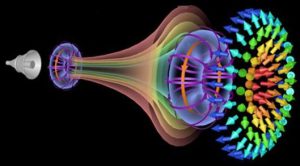These semi-stable toroidal electromagnetic structures were first theoretically proposed in 1995 by Hellwarth and Nouchi at the University of Southern California, Los Angeles.
Since then, according to the China-Singapore team, they have been demonstrated at optical and terahertz frequencies, but not microwave frequencies, until now.
The Hellwarth-Nouchi toroid transmit antenna, to which the University of Southampton contributed, is a coaxial horn constructed from two linear cones, where the space between the two cones is the active volume.
It measures 250mm across at the output, is ~220mm long, and is essentially a continuation of its coaxial feed cable – with the cable outer conductor connected to the outer horn and the inner conductor connected to the inner horn. Bandwidth spans 1.3GHz to at least 10GHz.
“The principle involves utilising ultra-wideband, radially polarised, conical coaxial horn antennas to create a rotating electromagnetic wave structure,” according to the researchers. “When the antenna emits, it generates an instantaneous pressure difference that forms these vortex rings, which maintain their shape and energy over long distances. The uniqueness of this method lies in its ability to produce electromagnetic pulses with complex topological features, such as skyrmions, that showcase remarkable resilience and self-healing properties during propagation.”
Potential applications are foreseen in data transmission where “the unique spectral and polarisation characteristics of the vortex rings allow them to carry more information compared to traditional waves”, they continued, or remote sensing: “By analysing the unique patterns of these vortex pulses, we can develop precise and reliable methods for detecting and locating objects.” Also “the skyrmion textures embedded within the vortex rings offer intriguing possibilities for topological data storage and processing”.
The work is described in the Applied Physics Reviews paper ‘Observation of resilient propagation and free-space skyrmions in toroidal electromagnetic pulses‘.

